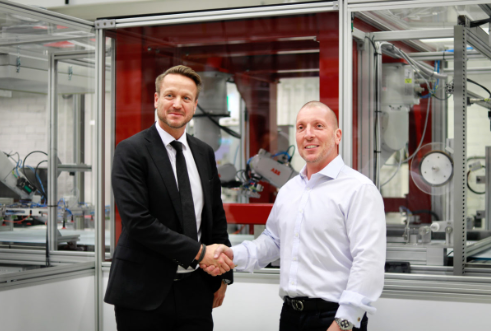A next-generation type dye-sensitized solar cell factory being planned in Sweden will bring hundreds of jobs as well as pumping out a product that could lengthen the lifespan of batteries in portable electronics indefinitely.
That is the claim made by Giovanni Fili, founder and chief executive of Swedish company Exeger, which has announced plans to develop the factory at an unspecified location with the help of Swiss electronics multinational ABB.
The new fab is intended to commercialize Exeger’s cell technology after Japanese conglomerate Softbank provided a $10 million shot in the arm in September for a company which also numbers Swedish pension fund AMF and Finnish energy company Fortum among its investors.
Exeger’s cell is intended for integration with consumer electronics. Sports helmet maker POC has just teased an Exeger-enabled ‘smart helmet’ at the Rouleur Classic bike show in London which features lights and sensors to track fitness performance, for example. The manufacturer said the helmet will be available next year.
Transparent conductive oxide layer
ABB will help design Exeger’s factory which, CEO Fili told pv magazine, will make extensive use of automation, internet of things applications and machine learning, as well as robotics. Fili said the facility will be ten times bigger than the company’s existing plant and said he hopes it will open around 2023.
Exeger’s ‘light-harvesting material’ – the description the company prefers to ‘cell’ – is layer printed and flexible and can come in various shapes, colors and textures. Fili said conventional dye-sensitized solar cells use a transparent conductive oxide (TCO) layerwhich is, it turns out, not very conductive. In most applications, this would be an indium tin oxide layer which, to fulfill its function, requires a grid of silver linings to be applied to it. That constraint the cell to rectangular designs with stripes.
The Swedish manufacturer has replaced the TCO with its proprietary material. “Our conductive layer is 1,000 times more conductive than what is normally used,” said Fili. That ensures higher conversion efficiency, ensuring the dye-sensitized inspired device is commercially viable. The company grapples with the connection to dye-sensitized technology because Exeger’s modification of the conductive layer allowed it to make bigger structural modification to the material design, to the effect that it is not under the copyright of EPFL, as is the case with conventional dye-sensitized cells.
The chief executive explained he did not want to categorize his company’s product in terms of conversion efficiency and its chemical makeup because the cell performs more effectively outside direct sunlight.
Small devices, big energy savings
“In direct sunlight our material performs worse than silicon but in diffuse light conditions, like under an umbrella, indoors [and] under artificial light, our product is much more efficient,” Fili said. He conceded the best dye-sensitized devices can reach a conversion efficiency of around 14% and said that figure rises to almost 30% indoors. Exeger’s light-harvesting material, he added, is free of rare earth and toxic materials.
In August, researchers at the Institute for Integrated Cell-Material Sciences at Japan’s Kyoto University claimed to have developed a dye-sensitized solar cell with 10.7% efficiency. In their study, Renaissance of Fused Porphyrins: Substituted Methylene-Bridged Thiophene-Fused Strategy for High-Performance Dye-Sensitized Solar Cells – published in the Journal of the American Chemical Society – the scientists claimed their device was the most efficient technology available for dye-sensitized cells with fused porphyrin sensitizers.
Exeger’s device can be integrated into products including Bluetooth speakers, headphones and tablet computers substantially reducing the need for battery power. Fili said one device which is due to be announced next month has been used by Exeger office staff for months without a charge. “This is also good for battery life because the batteries don’t cycle,” said the CEO. “The batteries are always at 70-90% charge.”
The Exeger founder added: “Sometimes I am asked why we are not going into primary energy production with our product but [instead] work with electronic gadgets. I like to tell these people that, according to a study in 2017, the U.S. used 143 TWh to charge consumer electronics. That is the entire energy consumption of Sweden. So our product will make a difference when it is integrated at scale.”






